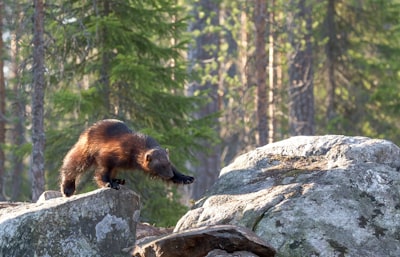
Wolverine Limits: The Ongoing Dispute Between Alberta’s Trappers and Researchers
The debate over wolverine limits in Alberta has highlighted a significant divide between trappers and researchers. The recent decision to lift trapping restrictions on wolverines, along with other fur-bearing animals, has sparked intense controversy. At the heart of this dispute lies the challenge of balancing traditional trapping practices with the need for comprehensive scientific research aimed at understanding and conserving wolverine populations.
Key Takeaway: Achieving a sustainable management strategy for Alberta’s wolverine population requires a delicate equilibrium between trapping activities and research efforts. This approach is vital not only for the conservation of these elusive carnivores but also for maintaining the broader ecological balance within the region. Understanding both sides of this debate is crucial for fostering collaboration and devising effective solutions that respect both wildlife conservation goals and the cultural significance of trapping.
The Role of Wolverines in Alberta’s Ecosystem
Wolverines play a crucial role in Alberta’s ecosystem as apex predators, helping to maintain the health of the ecosystem. Their presence ensures a balanced predator-prey dynamic, which is essential for the overall stability and biodiversity of the region. These elusive carnivores primarily feed on small mammals and carrion, helping control prey populations and prevent overgrazing.
The Importance of Wolverines Beyond Predation
The significance of wolverines goes beyond their role as predators. By regulating prey species dynamics, wolverines indirectly support plant and insect communities, fostering a rich and diverse ecosystem. This balance is vital for sustaining healthy forests and preventing the degradation of habitats crucial to numerous other species.
The Impact of Wolverine Populations on Biodiversity
Research has shown that changes in wolverine populations can lead to significant shifts in prey species numbers, affecting the entire food web. Their scavenging habits also contribute to nutrient cycling by dispersing nutrients through different areas. Therefore, understanding how wolverine populations impact biodiversity highlights their essential role in Alberta’s ecological system.
The Misunderstood Nature of Wolverines
Although often misunderstood due to their solitary behavior, wolverines are important parts of an interconnected environment. Addressing their conservation is not just about protecting one species but ensuring the resilience and vitality of Alberta’s vast natural landscapes.
Understanding the Current Trapping Regulations in Alberta

Alberta’s trapping regulations play a crucial role in wildlife management practices, specifically concerning wolverines and other fur-bearing animals. These regulations are designed to ensure that trapping activities contribute to sustainable wildlife management and ecological balance.
Key Aspects of Alberta’s Trapping Regulations
- Species-Specific Management: Trapping seasons and quotas are determined based on population data for each species.
- Winter Harvesting for Wolverines: The wolverine trapping season usually coincides with winter when their pelts have the highest value, promoting responsible harvesting.
- Licensing and Reporting Requirements: Trappers must follow strict rules such as obtaining licenses and reporting their harvests to help monitor populations and make necessary adjustments to regulations.
- Sustainability Focus: The main goal of these regulations is to prevent over-exploitation by controlling the number of animals trapped and ensuring healthy wolverine populations.
Ongoing Challenges in Conservation
While these regulations aim for sustainability, there are ongoing challenges:
- Critics argue that outdated population estimates can hinder conservation efforts.
- The recent decision to lift limits on wolverine trapping has sparked debates about the effectiveness of current measures.
- Balancing economic interests with conservation needs remains a key challenge for policymakers working on revising Alberta trapping regulations.
These discussions highlight the complexities involved in managing wildlife resources where multiple stakeholders have competing priorities.
Minister Todd Loewen‘s Controversial Announcement: Lifting Trapping Limits on Wolverines

The recent decision by Alberta’s Minister of Forestry and Parks, Todd Loewen, to lift trapping limits for wolverines has sparked a heated debate among stakeholders. This move, part of a broader regulation change affecting other fur-bearing animals like lynx and river otters, has brought the spotlight back on wolverine management in the province.
Key Details of the Announcement
- Regulation Change: The lifting of trapping limits specifically targets wolverines, which previously faced significant restrictions due to concerns about their dwindling numbers.
- Objective: According to Minister Loewen, this decision aims to gather more accurate population data on wolverines through increased interactions with trappers.
Motivations Behind the Decision
Understanding the motivations that led to this contentious regulation change involves examining several factors:
- Data Collection Needs: The classification of wolverines as “data deficient” under Alberta’s Wildlife Act highlights a pressing need for updated population estimates. Minister Loewen argues that engaging trappers actively can provide real-time data critical for wildlife management.
- Balancing Traditional Practices and Conservation Goals: The decision reflects an attempt to reconcile traditional trapping practices with conservation objectives. By involving registered trappers in data collection efforts, there is potential to align both interests.
- Economic Considerations: Trapping remains an economic activity for many in Alberta, contributing to local livelihoods. Removing limits might alleviate economic constraints faced by trappers while also serving research purposes.
This announcement marks a pivotal moment in Alberta’s wildlife management narrative, setting the stage for ongoing disputes between researchers and trappers over sustainable practices and conservation priorities.
Diverging Perspectives: Wildlife Conservationists vs. Trappers’ Community
The decision to lift trapping limits on wolverines in Alberta has sparked a heated debate, highlighting diverging perspectives among key stakeholders. Wildlife conservationists express significant concerns over the potential negative impacts on wolverine populations and the broader ecosystem. They argue that increased trapping pressure could exacerbate the decline of an already vulnerable species. Conservationists emphasize that wolverines play a critical role in maintaining ecological balance, and any disruption in their numbers could have cascading effects on prey species dynamics and overall biodiversity.
On the other hand, the Alberta Trappers Association supports the regulation change, underscoring their commitment to being responsible stewards of the land. They argue that registered trappers can provide valuable real-time data on furbearer populations through harvest registrations, contributing to more accurate population assessments. This perspective suggests that trappers have an intimate understanding of local ecosystems, which can be leveraged for effective wildlife management.
The contrasting viewpoints illustrate a broader tension between traditional practices in wildlife management and conservation goals aimed at protecting vulnerable species. By understanding each side’s arguments, one can appreciate the complexity of balancing human activities with ecological integrity in Alberta’s wilderness.
Exploring Alternative Approaches: Balancing Research Needs with Sustainable Practices
Non-lethal population monitoring methods present a promising alternative to lethal trapping for understanding wolverine populations. These techniques not only safeguard individual animals but also provide vital data for sustainable wildlife management. DNA sampling from hair snares and scat collection offers insights into genetic diversity and population size without harming the animals. Radio collaring, another non-invasive technique, tracks movement patterns, home ranges, and habitat use, providing comprehensive data that informs conservation strategies.
Embracing these methods requires cooperation between researchers and trappers. Building trust involves acknowledging the value each party brings to wildlife management. Trappers possess extensive knowledge of local ecosystems, which can complement scientific research efforts. A collaborative approach ensures that both research objectives and traditional practices are respected.
Finding a middle ground is essential for maintaining viable wolverine populations while fulfilling research needs. By integrating non-lethal methods into standard practices, stakeholders can work towards a shared goal of preserving Alberta’s biodiversity. This balance supports long-term ecological health and aligns with sustainable wildlife management principles, ensuring that wolverines continue to thrive in their natural habitat.
The conversation surrounding these methodologies opens doors to exploring how both communities can jointly contribute to conservation efforts and effective wildlife management policies.
The Future of Wolverines in Alberta: A Call for Collaboration Between Stakeholders
The ongoing clash between trappers and researchers in Alberta over wolverine limits highlights the urgent need for collaborative wildlife management strategies. Ensuring the long-term survival of wolverines requires a concerted effort from all stakeholders, including trappers, researchers, and policymakers.
Potential Ways Forward:
- Establish Joint Monitoring Programs: Bringing together expertise from both sides to create comprehensive monitoring initiatives can provide valuable insights into wolverine populations without increasing mortality rates.
- Targeted Habitat Restoration Initiatives: Focus on restoring critical habitats to support wolverine population recovery, preserving the ecological balance.
Collaborative approaches not only enhance data accuracy but also foster mutual understanding and respect among stakeholders. By working together, Alberta can develop sustainable practices that protect these elusive carnivores while addressing the needs and concerns of diverse communities.
FAQs (Frequently Asked Questions)
What is the ongoing dispute regarding wolverine limits in Alberta?
The ongoing dispute over wolverine limits in Alberta centers on two key stakeholder groups:
Trapper Perspective:
- Argue for maintaining traditional harvest quotas
- Cite generations of sustainable trapping practices
- Express concerns about economic impact of stricter limits
- Point to local knowledge and field experience
Researcher Position:
- Advocate for reduced trapping quotas
- Present data showing population vulnerabilities
- Emphasize need for precautionary management
- Highlight climate change impacts on habitat
Key Areas of Contention
- Population Assessment Methods
- Disagreements over accuracy of current monitoring
- Questions about methodology reliability
- Debate over traditional vs. scientific tracking
- Economic Considerations
- Impact on trapper livelihoods
- Value of fur industry
- Cost of research programs
- Management Approaches
- Differing views on quota systems
- Dispute over seasonal restrictions
- Disagreement on protected areas
“The challenge lies in finding common ground between traditional practices and scientific evidence while ensuring wolverine population sustainability.” – Alberta Wildlife Management
This complex situation reflects broader challenges in wildlife management where traditional practices intersect with contemporary conservation science, requiring innovative solutions that respect both perspectives.
Why are wolverines important to Alberta’s ecosystem?
Wolverines play a crucial role as apex predators in maintaining healthy ecosystems. Their populations influence prey species dynamics and contribute to overall biodiversity, making their ecological significance paramount. These resilient carnivores serve multiple vital functions:
Key Ecosystem Services:
- Act as natural scavengers, helping prevent disease spread
- Control prey populations, particularly small mammals
- Distribute nutrients across vast territories through their extensive travel patterns
Habitat Impact:
- Create denning sites that benefit other species
- Maintain natural balance in remote alpine regions
- Help regulate ungulate populations in boreal forests
Their presence indicates ecosystem health, as wolverines require:
- Large, undisturbed territories
- Diverse prey populations
- Connected wilderness corridors
“Wolverines are considered an umbrella species – their protection benefits numerous other species sharing their habitat.” – Alberta Wildlife Research
These remarkable predators influence both terrestrial and aquatic ecosystems through their:
- Wide-ranging movement patterns
- Diverse dietary habits
- Interaction with other predator species
What are the current trapping regulations for wolverines in Alberta?
Alberta’s trapping regulations incorporate a comprehensive framework designed to ensure sustainable wildlife management. The regulatory system includes specific provisions for different species and regions, with particular attention to sensitive species like wolverines.
Key Regulatory Components
- Registered Fur Management Areas (RFMAs)
- Designated zones for licensed trappers
- Specific quotas and restrictions per area
- Annual reporting requirements
- Seasonal Restrictions
- Defined trapping seasons
- Species-specific timing windows
- Weather-dependent adjustments
License Requirements
Licensed trappers must:
- Complete mandatory training programs
- Maintain detailed harvest records
- Submit annual reports to wildlife authorities
- Renew permits according to schedule
Monitoring and Enforcement
The regulatory framework includes:
- Population Monitoring
- Annual wildlife surveys
- Track population trends
- Assess habitat conditions
- Compliance Measures
- Regular field inspections
- Equipment standards verification
- Documentation reviews
“Alberta’s trapping regulations prioritize long-term species viability while supporting traditional harvesting practices.” – Alberta Trappers Association
Conservation Considerations
Regulations incorporate:
- Habitat protection measures
- Population recovery strategies
- Indigenous rights and traditional practices
- Scientific research findings
What was Minister Todd Loewen’s announcement regarding wolverine trapping limits?
In a significant policy shift, Alberta’s Minister of Forestry and Parks, Todd Loewen, announced the removal of trapping limits for wolverines across the province. The announcement, made during a press conference in Edmonton, outlines several key changes:
- Elimination of the previous quota system
- Removal of seasonal restrictions on wolverine trapping
- Implementation of new reporting requirements for trappers
The minister’s decision stems from what he describes as “sufficient population recovery” in certain regions, though this assessment has been met with mixed reactions from various stakeholders.
Key Elements of the New Policy
- Immediate Implementation
- Policy took effect in the 2023-24 trapping season
- Applies to all registered trapline holders
- Maintains existing license requirements
- Modified Reporting Structure
- Enhanced documentation requirements
- Mandatory submission of DNA samples
- Monthly harvest updates to wildlife officials
“This adjustment reflects our commitment to evidence-based wildlife management while supporting Alberta’s trapping heritage.” – Minister Todd Loewen
The announcement represents a significant departure from previous conservation-focused policies, prompting discussions among wildlife biologists, indigenous communities, and environmental organizations about the potential ecological implications of unrestricted wolverine harvesting.
What are the differing perspectives between wildlife conservationists and trappers regarding wolverine management?
Wildlife conservationists raise several key concerns about increased trapping:
- Population vulnerability due to wolverines’ naturally low reproduction rates
- Potential disruption of ecosystem balance where wolverines serve as apex predators
- Risk to genetic diversity in isolated populations
- Impact on ongoing research and monitoring programs
“The removal of even a small number of wolverines can have significant ripple effects throughout the ecosystem” – Dr. Sarah Mitchell, Wildlife Conservation Society
Trappers’ Position
The Alberta Trappers Association (ATA) presents counterarguments supporting regulation changes:
- Traditional Knowledge: Generations of experience in sustainable harvesting
- Population Indicators: Reports of increased wolverine sightings and encounters
- Economic Considerations: Impact on trapping livelihoods and local economies
- Management Expertise: Firsthand observation of wildlife patterns and behaviors
Field-Based Evidence
Recent field observations reveal:
- Increased wolverine tracks in traditional trapping areas
- More frequent interactions with human infrastructure
- Expanded range into previously unoccupied territories
- Growing conflicts with livestock operations
These observations contribute to the ongoing debate between conservation needs and traditional resource use.
What alternative approaches could be considered for monitoring wolverine populations?
Scientific monitoring approaches have evolved significantly, offering several alternatives to traditional methods:
DNA Analysis Methods
- Hair Snares: Strategic placement of hair collection stations using scented lures
- Environmental DNA (eDNA) sampling from snow tracks and den sites
- Scat Collection: DNA extraction from droppings to identify individuals
Technology-Based Solutions
- Remote Camera Networks
- Motion-triggered wildlife cameras
- Infrared night vision capabilities
- AI-powered image recognition
- GPS Tracking
- Lightweight collars with minimal impact
- Real-time movement data
- Habitat use patterns
Citizen Science Initiatives
- Mobile apps for reporting wolverine sightings
- Community-based tracking programs
- Traditional ecological knowledge integration
“Modern monitoring techniques allow us to gather more detailed data while minimizing wildlife disturbance” – Dr. Michael Thompson, Wildlife Biologist
Collaborative Research Methods
- Den Surveys: Non-invasive monitoring of reproductive sites
- Track Surveys: Systematic snow tracking in winter
- Remote Sensing: Satellite imagery for habitat assessment
These methods provide valuable data while addressing both conservation concerns and the need for accurate population assessments.





















